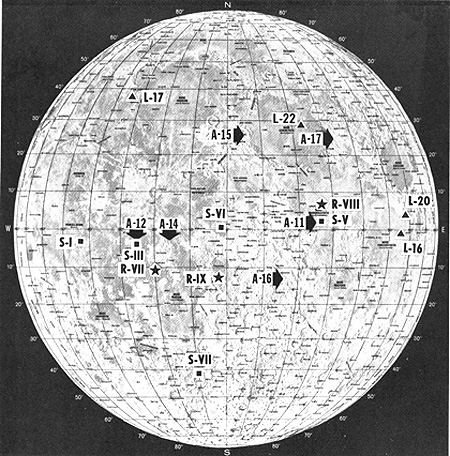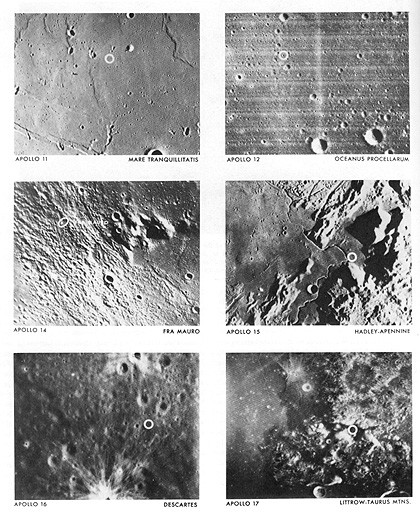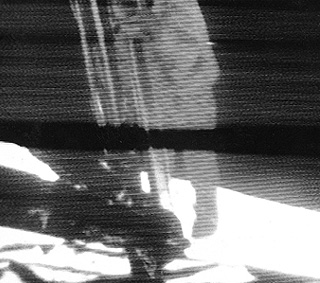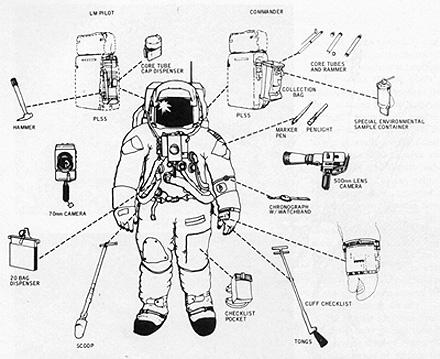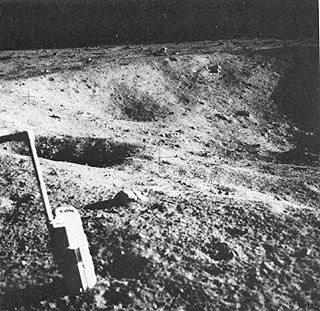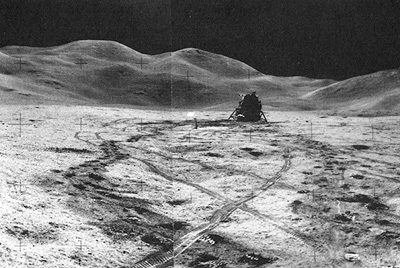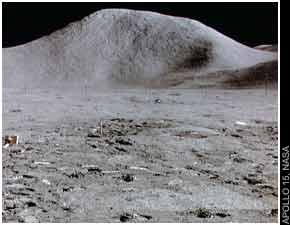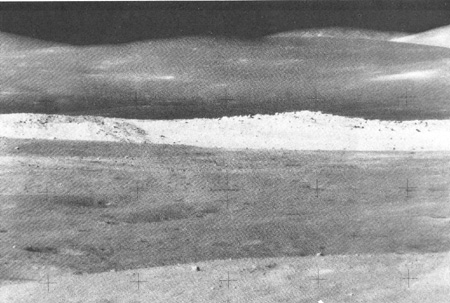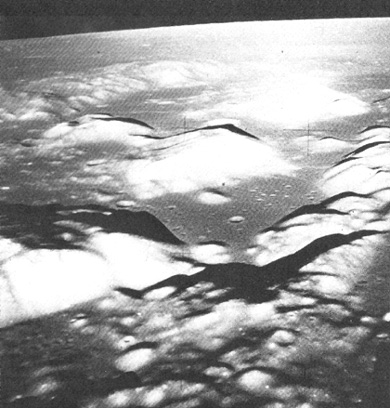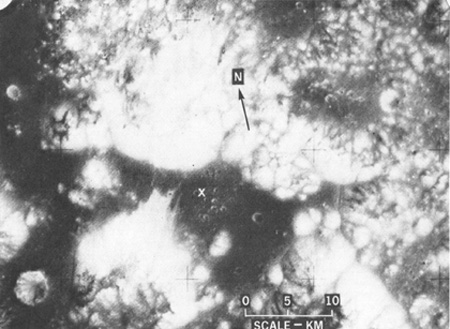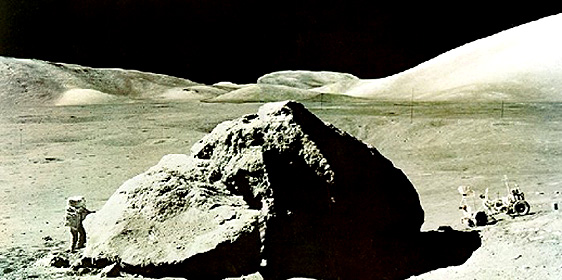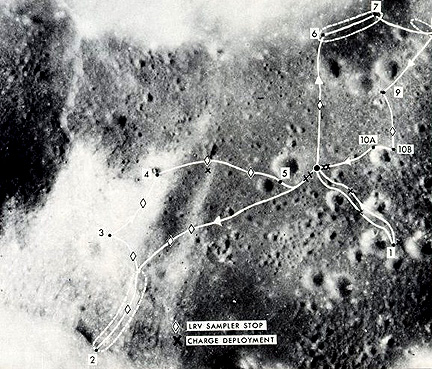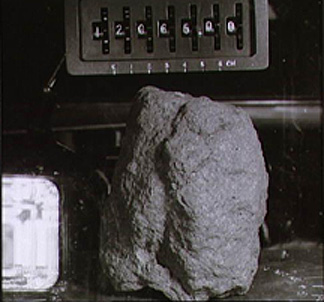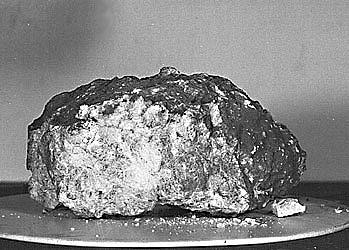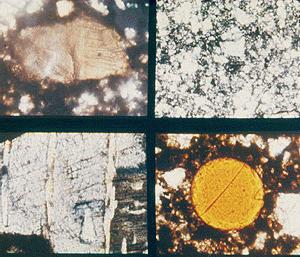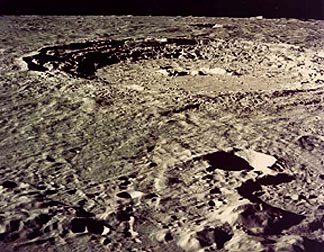The Apollo Program - Man on the Moon¶
The pinnacle of the lunar exploration programs of the United States - the response by NASA and many other organizations to the challenge of President J.F. Kennedy to land astronauts on the lunar surface and return them safely to Earth - was the highly successful series of 9 flights to the Moon, six of which actually reached its surface. This page recounts the achievements of that effort - perhaps the greatest sojourn in human history. The collection and return of 810 pounds of rocks and soil was the top accomplishment. These rocks are mostly basalts, anorthosites, and breccias that are mineralogically similar to but chemically different from Earth rocks. The majority of lunar samples have formation ages between 3.7 and 4.2 billion years - older than nearly all terrestrial rocks in Earth’s crust. Various instruments were deployed and extensive photographic documentation from both the ground and from the orbiting Command and Service Module added to the triumphs of the missions. But, the ultimate success was to prove, by doing, that space explorers can live and operate on other planetary surfaces.
The Apollo Program - Man on the Moon¶
Either before or after reading through the next three pages, you may wish to consult an excellent online summary of the Apollo Expeditions to the Moon.
The Lunar Orbiters had earlier imaged each site at various times; examples are seen in this next set of panels:
The following table summarizes the science rationale for visiting each site:
The Apollo 10 astronauts had previously reached and orbited the Moon without landing during Christmas of 1968. This emboldened NASA to send the first trio of astronauts, Neil Armstrong, “Buzz” Aldrin, aqnd Michael Collins, in the summer of 1969 to attempt a landing near the south edge of Mare Tranquillitatis, chosen for its flatness and relative sparsity of larger craters. Their final approach was captured by a photo out the LM window which showed both the landing site ahead and the many guiding landmarks (given quaint names as was the custom) visible ahead:
The touchdown point at Apollo 11 is plotted on this Lunar Orbiter photomap:
It was mid-afternoon (4:17 PM EDT) on July 20, 1969 that the Apollo 11 LM touched down safely on the lunar surface, much to the relief of the program people at Houston Mission Control and to an anxious but excited world. Six hours later came one of the greatest moments in human history, immortalized in this TV image of the first astronaut to descend to the surface. (If you have forgotten his name and his famed quotation, check the caption; also, face the question: If he were first out, who was holding the TV camera?) Of course, you should remember his “immortal” first worlds: “One small step for (a) man; one giant leap for mankind!” (The ‘a’ in parenthesis is what he intended to say but this is not heard in the broadcast audio.)
Each astronaut involved in excursions after landing was well-equipped to operate in the low gravity (1/6th that of Earth), airless surficial environment, as depicted in this figure:
A view of a small, local crater near the Apollo 11 LM is typical of mare scenery at that site:
Apollo 11 and 12 sites were both in mare terrain. Apollo 12 also sat astride ejecta within a ray coming from the crater Copernicus. Apollo 12 represented a remarkable achievement in navigation, setting down within easy walking distance of the Surveyor III spacecraft remaining from an earlier mission,; pieces of Surveyor were returned to Earth to study the wear on its surface from micrometeorite bombardment. Here it is, with the LM in the background:
` <>`__19-19: What happened to Apollo 13; did it “go” and if so why didn’t it touch down on the Moon? `ANSWER <Sect19_answers.html#19-19>`__
Apollo 14 was in Fra Mauro ejecta, emanating from the huge cratering event that produced the Mare Imbrium Basin. Some of that ejecta was scattered about Cone Crater, in the top view of this next illustration; a close-up of this ejecta is in the bottom view:
Apollo 15 landed near the Apennine Mountains, made of rim rocks, which are lunar crust, pushed up when the Imbrium Basin formed. These mountains, shown in the background of the next (top) view that also pictures the LM, rose as high as 4.2km (about 2.8 miles). The highest on the Moon, Mt Hadley (bottom), reaches to 4.5 km (14765 ft).
` <>`__19-20: What might have caused these mountains, since the Moon does not have a plate tectonics system like on Earth. `ANSWER <Sect19_answers.html#19-20>`__
A mobile, self-powered vehicle, the Lunar Rover, was first used at the Apollo site to transport the astronauts on long (kilometers) excursions to vist places too far for foot excursions. The Rover, also called the “Lunar Buggy” is equipped as indicated in this schematic:
Apollo 15 also carried the third seismometer emplaced on the Moon. After it was deployed and sent back good data, the simultaneous operation of the three working instruments permitted calculations of the seismic properties of the lunar interior. Several models have been proposed: here is one put forth by M. Toksöz (other investigators argue for a small metallic core); read its caption for more details.
the highlands (anorthositic) crust averages 60 km in thickness and has surface extrusions of mare lava (black); a thick mantle overlies an asthenosphere (hot, plastic, partially molten rock in which seismic S waves are slowed); moonquakes occur near the base of the mantle where still rigid rock adjusts to the interior flow.|
Apollo 16 was the only lunar manned mission to visit true highlands terrain. The spacecraft landed in the Descartes Mountains; the site is shown in this Apollo photograph:
This Apollo 16 view encompasses the plains, a terrace, and low mountains in the background:
The Apollo 16 astronauts main goal was to sample Highlands units, both in the hills and the lower units consisting of the Cayley Formation, making up part of what the USGS astrogeologists believed to make up the Cayley Plains. By their earthbound interpretation, these supposedly were volcanic deposits, perhaps of pyroclastic nature, but these were shown during and after the mission to be consolidated impact ejecta. A small crater and hills beyond, as shown below, are typical of this highlands landscape:
The Apollo 17 landing site was in the Taurus-Littrow region, where the last visit to the Moon occurred in December, 1972. Here is the approach to this site as photographed from the orbiting Command Module.
This vertical photo shows the landing site for Apollo 17 and some key features in the area including the dark, flatter volcanic units which proved to be mare basalts in nature.
Apollo 17 also sought volcanic pyroclasic units, predicted to occur around the Taurow-Littrow Mountains but, except for the notable orange layers (glass droplets splashed out of mare lavas before they hardened) within the regolith (debris “soil”), the rocks exposed in the massifs (high hills) were again made of ejecta. Some of the rocks at the 17 site were huge, as indicated by this view of “Split Rock” which consisted of a consolidated ejecta (a breccia); astronaut-geologist Harrison H. “Jack” Schmitt is standing nearby:
Against the backdrop of the site photo, this map shows the paths followed by astronauts Jack Schmitt and Eugene Cernan as they used the Lunar Rover to traverse to various sampling and instrument emplacement locations.
Familiarize yourself with the geography of this scene, and note especially the patterns of the massifs (hills in the highlands) that stand out as bright against the darker central lava-covered plains around the touchdown site. Now, look at this ground scene:
Astronaut Jack Schmitt (a geologist and the only career scientist to walk on the Moon) took the photo, partly to show the Lunar Module (LM) sitting safely on the plains against a background of a massif (mountain block) composed of breccias (see below). Astronaut Eugene Cernan is at the controls of the mobile Lunar Rover, used for excursions up to several miles from the LM.
` <>`__19-21: Scroll back to the two photos showing the massifs at Apollo 17 and to the vertical photo taken from the orbiting Command Module. Can you tell which photo shows the North and which the South massifs? `ANSWER <Sect19_answers.html#19-21>`__
One of the prime goals for discovery at the Apollo 17 site was evidence of volcanism other than invasion by mare basalts. The U.S. Geological Survey had forecast that volcanic deposits transported above the surface should be present. There was a moment of high excitement when one of the astronauts suddenly spotted an orange layer in the regolith (surface “soil” debris), as photographed by him here:
When samples of the orange layer were studied after return to Earth, the material was seen to consist of small black glass spherules and chips of orange glass. These are believed to be splash droplets tossed out of cooling lava during impacts into still fluid target lavas (probably with a solid surface crust). This is what they looked like back on Earth:
|The particles of black and orange glass, principally of volcanic origin (crater ejecta |
You may be interested in this Web site prepared byJack Schmitt in which he has summarized his Apollo 17 experiences, with emphasis on the observations and results made during the mission.
Apollo 17 also shed some proof on a prediction made by the writer (NMS). Just before the Apollo 15 mission, he had attempted to calculate the thickness of the ejecta deposits that he had proposed as the principal surface units in the Highlands. The basis for this calculation was simply to determine the amount of material that would be excavated and tossed out of lunar (impact) basins and craters larger than 1 km on the frontside of the Moon. A terrestrial cratering model was assumed. The result indicated thicknesses on the Highlands to range between < 1 km to just over 3 km. Maximum thicknesses would be near the edge of large basins; the central Highlands would contain, on average, about a kilometer of ejecta (on the surface of which would develop, both in the Highlands and the Maria, a thin surface layer - the regolith). After Apollo 15’s seismograph began operating, indications favored a widespread low velocity layer on the Highlands which seemed to correspond to this ejecta unit. The writer published this generalized isopach (thickness) map shortly thereafter:
As preparations were made to send Apollo 17 to Taurus-Littrow, between and east of the Mare Serenitatis (7) and Mare Tranquillitatis (11) Basins, the writer determined from this map a thickness of 3 km for that site. On landing, astronaut Harrison H. (Jack) Schmitt noticed that North Massif was a 1.5 kilometer high mountain made up entirely of breccia (consolidated ejecta). A small portable seismometer then determined that there was a kilometer and a half of low velocity (ejecta) below the site. These two observations totaled 3 kilometers, either a remarkable confirmation of the isopach map at that point or a very lucky coincidence. (NOTE added on March 25, 2003: The writer (NMS) spoke with Jack Schmitt when the latter visited Bloomsburg University the previous day, and was able to gather additional details on the stratigraphy. He said that the ejecta deposits above the valley floor was from the Imbrium Basin. Below the floor were a kilometer and a half of mare basalts. Then, a second ejecta interval derived mainly from older Serenitatis Basin impact excavation was beneath that; its thickness exceeded a kilometer.)
The dominance of breccias (most if not all being consolidated lunar ejecta) at Apollos 16 and 17, and the prevalence of this type of rock in the Fra Mauro formation at Apollo 14, supports the idea that the lunar highlands is composed of up to several kilometers of ejecta breccia, probably overlying an anorthositic crust. The unconsolidated regolith at the surface is a superficial deposit. Breccias likely were covering the crustal surface when huge impacts - the basins - removed them for redistribution, followed by invasion of the mare lavas that remain today.
The Apollo program remains the paramount achievement of Man in Space. The greatest reward from the journeys to the Moon lies in the nearly 368 kilograms (810 pounds) of rock samples collected by the astronauts. Almost three decades later, scientists continue the most intense analysis and scrutiny of any natural substances taken from a planetary body. Starting in 1970, every year in March, hundreds of geoscientists meet at the Johnson Space Center near Houston, Texas, for the annual Lunar and Planetary Science Conference, to report on new findings and exchange hypotheses on the interpretation and implications of recent data. From examining the lunar rocks several fundamental ideas have emerged: differentiation of a primitive planetary body, the nature of its early surface, the pre-eminence in non-mare rocks of shock effects from impact cratering, the age and history of the Moon, and its origin. The prevailing opinion is that it derived from accretion of terrestrial debris hurled into space after being ejected from a huge impact on the early Earth that resulted in crustal/mantle materials attaining orbital velocities. A variant of this model, held by some, is that much of the material came from the incoming body, probably an asteroid whose size approached that of Mars).
The appearance of typical lunar rock specimens is shown in the next four photos:
First is a specimen of lunar basalt from the Apollo 12 site; it is fine-grained and pitted by micrometeorite bombardment. This is the prevalent rock type in the maria.
Next is an anorthositic gabbro, a whitish rock dominated by feldspar. It is probably typical of the bulk of the original lunar crust, representing crystals of plagioclase that floated upwards in the cooling magma that developed during the Moon’s first general melting. Note the black glass that coats part of the sample, presumably plastered on the rock as it was transported from an impact crater that made the glass.
Third is an unusual rock found first at the Apollo 12 site (sample 12013). It contains two color phases: light (shown here) and dark:
The light phase is described as a felsite (fine-crystalline equivalent to a granite) and has a higher silica (SiO:sub:2) content than most lunar samples. It contains potassium feldspar and needles of quartz. Because it is high in potassium (chemical symbol K), the rare earth elements (REE), and phosphorus (P), it is representative of the lunar rock class called KREEP. (Note its position in the diagram at the bottom of this page.) Other examples were found at later Apollo sites, particularly Apollo 14. Current thinking is that this very old rock may be a sample of the original lunar magma which suggests that crust formed from it was more granitic. A variant of this idea holds it to be the top differentiate of a magma that gave rise to a more general anorthositic crust beneath.
Finally, from the Apollo 17 site, the large central rock is a breccia, that is, a rock composed of fragments of other rocks that accumulate from various (usually distant) sources which are then welded together by heat and pressure.
The large central rock is a breccia, that is, a rock composed of fragments of other rocks that accumulate from various (usually distant) sources, which heat and pressure then weld together. These fragments represent impact debris from more than one area of the Moon that make up the principal deposits of the outer layers of the Moon, i.e., part of the 1-3 km (about 0.62-1.86 miles) thick, lunar-ejecta blanket, first proposed and described in 1971 by this writer (NMS; see above). The dark material in this specimen is basalt, the solidified end product of iron-rich lava that fills lunar marias. The lighter rock fragments probably originated from the lunar highlands, which we see from Surveyor and Apollo samples that show them to consist of rocks with a high percentage of grayish feldspars (Ca-Na aluminosilicates) that cause the highlands to appear lighter in tone (higher albedo or reflectivity). The smaller rock samples surrounding the large specimen are vesicular basalt pieces (dark) and individual highlands rocks (light), collected nearby on the same mission.
At every Apollo site, the surface was covered with fine fragmental material, the lunar soil (technically called regolith) which lay atop the lunar ejecta blanket in deposits from meters to tens of meters thick. This material is the accumulation of debris brought in from near to distant source through cratering that tossed fragments of a wide size range beyond the rims. The deposits were then further comminuted by constant micrometeorite bombardment.
An important task for the astronauts was to drive drills into the regolith that allowed core to be removed intact. Here is Astronaut David Scott in process of coring at the Apollo 15 site and below that are recovered core samples from the Apollo 12 site.
The core samples were analyzed as intensely as the rocks returned from the Moon, but they told a different story. Their components roughly indicated the relative contributions from nearby versus faraway sources. Here is a plot of the relative proportions of different lithologies of coarser fragments in one core from Apollo 11 and several core samples from Apollo 12.
Basaltic rocks and breccias were predominant, indicating local sources provided most of the material. Anorthosites were carried to the sites from distant highlands. When mapped in detail, the cores clearly show multiple layers that differ in composition and size distribution, as expected whenever larger impacts tossed out significant ejecta to their surroundings.
Analysis of lunar samples brought to light several distinct features. Some breccias when individual fragments were examined disclosed definitive evidence of shock effects, indicating that these rocks were debris involved in major impacts. Shock effects were found also in lunar soil samples. The writer (NMS) in 1969 was one of the original 142 Principal Investigators selected to study the first lunar samples; my task was to search for shock effects, to be expected because of the prevalence of impacts into the outer surface. However, my earlier experience with shock features in basalt subjected to nuclear explosion led me to predict that these effects would be harder to find than in more silicic rocks such as granites. This proved true. Still, effects attributable to shock were observed rather frequently. This group of six photomicrographs (reread the page on shock metamorphism [p. 18-4]) depicts some examples (check the caption for descriptions):
I also prepared a second montage showing shock effects in color. Again, the description of each picture is in the caption.
The upper right photo warrants further discussion. This is a small rock fragment found in a breccia sample that almost certainly was a part of the now-lithified outer ejecta blanket described above on this page. The fragment consists almost entirely of pieces of plagioclase feldspar. The writer first set eyes on this fragment, in a “Eureka!!” moment in late October of 1969, while working on my P.I. tasks. As I peered through the microscope at this this fragment, I was suddenly aware of how much its texture was like that of the shock-lithified sandstones (“instant rock”) described on page 18-3. Shown below is a variation: instant rock made up entirely of feldspar fragments welded together by the implosion tube method described on page 18-3.
Another photomicrograph of this lunar fragment appears here.
I immediately formed a prescient postulate. What I was looking at is a piece of the highlands regolith that had been converted into instant rock by an impact that hurled this fragment a long distance from the highlands site only to land in the forming regolith at the Apollo 11 site. If this were correct, then I was in fact confirming the argument made by A. Turkevitch and his colleagues (see answer to question 19-13) that the highlands was made up of mostly anorthosites (feldspar dominant rock). This conclusion I reported during the first Lunar Science Conference (1970), as did John Wood of the Smithsonian Astrophysical Observatory.
Mineralogically, moon rocks are similar to several types found on Earth, except that the individual minerals are almost entirely unaltered by hydrothermal solutions, i.e., they are very “fresh” looking under the petrographic microscope. Basalts, anorthosites, and breccias (fragmental mixtures of several different rock types) are prevalent. The most common minerals are calcium plagioglase, several pyroxenes, olivine, and ilmenite (an iron-titanium oxide). Three new minerals, unknown on Earth, have been found: tranquillityite, armacolite, and pyroxferroite.
Chemically, the lunar rocks were mostly in a class by themselves, being different from their terrestrial rock type counterparts. They are deficient in iron, low in volatiles (including potassium and sodium), and are totally anhydrous (meaning that water was not present when they formed; water found on the Moon is discussed below); compared with Earth rocks, they were exceedingly fresh, showing almost no signs of alteration. As an example of their chemical specificity, examine this diagram which plots the ratio of potassium (K) to uranium (U) versus changing potassium content; note that both meteorites (chondrites and carbonaceous chondrites) and terrestrial igneous rocks plot in different areas of the diagram than the lunar rocks. However, the meteorite class Eucrites plots partly within the lunar samples field, suggesting that these are actually ejecta from the Moon that reached Earth.
` <>`__19-22: What conclusions can you draw from this K/U vs K (ppm) plot? `ANSWER <Sect19_answers.html#19-22>`__
None of the lunar rocks show ages as old as some meteorites (4.6 billion years [b.y.]). Radiometric dating (U/Pb; Rb/Sr; K/A decay methods) gave both model ages (times when initial materials appear to have formed) and formation ages (time when these materials melted and solidified to their present state). The youngest basaltic rocks came from the Apollo 12 site (exception: Sample 12013 [Apollo 12 site] is more than 4 b.y. old - it is an exotic emplaced as ejecta from the highlands); the oldest from Apollo 11 and 17 . The maria formation ages spread from around 3.2 to 3.85 b.y (none older). The major ringed basins such as Orientale and Imbrium, most now filled with basalt, seem to have formed about 3.9 b.y. ago whereas Serenitatis may be as old as 4.2 b.y. Thus, these basins took several hundred million years or more to fill.
Many highlands rocks, mostly anorthosites, show ages in the 4.0 to 4.2 b.y. range but the primordial crust formed sometime between 4.4 and 4.6 b.y. ago. No model age (older) was as old as the 4.6 b.y. estimated for the Earth, but the Moon is still considered nearly that old. It could be a 100 million years or so younger if the Earth impact origin remains as the mode of origin for the Moon (see page 19-6b).
A few large lunar craters have been formed during an era beginning less than 1 billion years ago. Copernicus may be about 800 m.y. old and Tycho perhaps less than 300 m.y. in age. This is inferred by extrapolation from crater counts on surfaces elsewhere whose estimated ages have been calibrated by radiometrically dated rocks.
The writer (NMS) was one of many planetary geologists arguing to make Copernicus a key part in the Apollo mission series. None through Apollo 17 actually went to a very large crater. A visit to one of the “biggies” would add valuable information about rocks and morphological features associated with these large structures. Before Apollo 17, there was debate about where that last mission would go. Impacters supported Copernicus but problems as to where to land (the interior near the rim was proposed) caused it to be rejected in favor of Taurus-Littrow (the writer was able to get his views as to why T-L would not meet the reasons given by the U.S. Geological Survey [they claimed the site would show abundant volcanism; the writer, using the above isopach map, predicted it would all be impact crater ejecta {as in fact it was}] in front of the site selection committee, advocated for him by Wm. Muehlberger). Although Apollo 18 had been cancelled before 17 succeeded, the astronauts on that mission took this photo of Copernicus in hopes that the abbreviation of the program could be circumvented.
*Copernicus is still there, awaiting a visit in a hoped-for renewed manned lunar exploration program that is a “must do” in the foreseeable future.*
